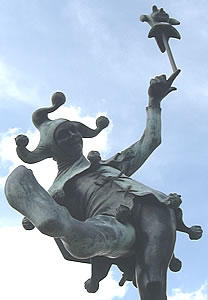Katrina Strikes the Big Easy

My Way News has the story from AP. The details:
Hurricane Katrina plowed into this below-sea-level city Monday with howling, 145-mph winds and blinding rain that flooded some homes to the ceilings and ripped away part of the roof of the Superdome, where thousands of people had taken shelter.Please keep all New Orleanders, and other victims of Katrina's fury, in your prayers. May God in his infinite mercy care for all caught in the midst of the storm. May his compassion comfort all afflicted by the hurricane.
Katrina weakened overnight to a Category 4 storm and turned slightly eastward before hitting land about 6:10 a.m. CDT east of Grand Isle near the bayou town of Buras, providing some hope that this vulnerable city would be spared the storm's full fury.
But National Hurricane Center Director Max Mayfield warned that New Orleans would be pounded throughout the day and that Katrina's potential 15-foot storm surge, down from a feared 28 feet, was still substantial enough to cause extensive flooding.
"I'm not doing too good right now," Chris Robinson said via cellphone from his home east of the city's downtown. "The water's rising pretty fast. I got a hammer and an ax and a crowbar, but I'm holding off on breaking through the roof until the last minute. Tell someone to come get me please. I want to live."
Along the Gulf Coast, the storm hurled boats onto land in Mississippi, lashed street lamps and flooded roads in Alabama, and swamped highway bridges and knocked out power to 28,000 people in the Florida Panhandle. New Orleans, which was in particular peril because it is so low-lying, was ordered evacuated over the weekend, and an estimated 80 percent of its 480,000 residents complied.
At the Superdome, home to 9,000 storm refugees, wind peeled pieces of metal from the golden roof, leaving two holes that let water drip in. People inside were moved out of the way.
Others stayed and watched as sheets of metal flapped and rumbled loudly. From the floor, looking up more than 19 stories, it appeared to be openings of about six feet long. Outside, one of the 10-foot, concrete clock pylons set up around the Superdome blew over.
"The Superdome is not in any dangerous situation," Gov. Kathleen Blanco said.
Scores of windows were blown out at some of New Orleans' hotels. At the Windsor Court Hotel, guests were told to go into the interior hallways with blankets and pillows and to keep the doors closed to the rooms to avoid flying glass.
At 10 a.m. EDT, Katrina was centered about 30 miles southeast of New Orleans. That put the western eye wall with some of the fiercest weather over New Orleans. The storms winds dropped to 135 mph as it pushed inland, threatening the Gulf Coast and the Tennessee Valley with as much as 15 inches of rain over the next couple of days and up to 8 inches in the drought-stricken Ohio Valley and eastern Great Lakes.
Katrina was a terrifying, 175-mph Category 5 behemoth - the most powerful category on the scale - before weakening.
Mayfield said at midmorning the worst flooding from storm surge was on the Mississippi coast, east of the eye, with the highest storm surge recorded so far at 22 feet in Bay St. Louis.
Along U.S. 90 in Mississippi, the major coastal route that is home to the state's casinos, sailboats were washed onto the four-lane highway.
"This is a devastating hit - we've got boats that have gone into buildings," Gulfport Fire Chief Pat Sullivan said as he maneuvered around downed trees in the city. "What you're looking at is Camille II."






















<< Home